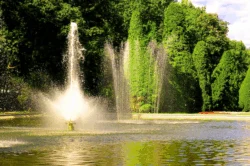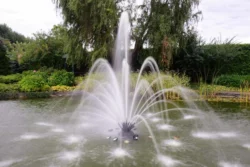A pond fountain can transform an ordinary water feature into a stunning focal point while providing essential aeration for aquatic life. Whether you’re considering installing a fountain in your existing pond or planning a new water feature, understanding fountain types, installation processes, and pump pricing is crucial for success.
Pond Fountain Selection
It is equally important to choose the correct size and style of the fountain before you begin to make structures. The most important decision to make is whether you require an aerating fountain or a display fountain. Both of these kinds of fountains offer displays, but there are two main differences. Aerating fountains produce more aeration than display (decorative) fountains because no nozzles are used. Rather, a propeller pushes water into the air above the fountain float. The display is limited to a V-pattern. Display fountains, also called decorative fountains, use a nozzle and the flow is restricted by the size and number of holes in the nozzle. Thus, not as much water is pushed into the air and there is less aeration. However, because decorative fountains use nozzles, displays can be quite intricate and dramatic, from geyser style to multi-tiered displays.
Pond Fountain Pump Costs
As with many products, the fountain pond pump price depends largely on several factors. Small ponds, for example, koi ponds, often use small pumps coupled with a nozzle. Larger ponds, e.g., 1/3 acre and larger, use mid-range pumps or industrial-grade pumps.
Mid-range pumps represent the intermediary price bracket while featuring more power and reliability than small pumps for koi ponds. Pumps can be housed in either heavy-duty plastic or stainless-steel cases. These are often purchased by homeowners who must consider budget issues when purchasing a floating fountain. Typically, warranties are shorter, but most companies sell replacement parts, and these fountains often produce a great deal of aeration.
Industrial-grade fountain pumps occupy the most expensive price bracket representing a notable purchase for serious pond enthusiasts. These high output units are designed for larger ponds and water features which include energy efficient motors and multiple spray pattern options. Warranties are almost always longer than for less expensive pumps.
Installation Steps
To install pond fountains, care must be taken at each step. Start with choosing the ideal spot concerning the wind direction and viewing angle. Usually, the installation steps consist of the following:
To start, measure how deep the pond is and choose how you will mount the pump. For instance, if you have a submersible pump in a small pond, e.g. for koi, you will need to use a stable and level base. For external pumps, you will need a proper housing unit with pumps that can be plumbed into.
For larger, floating pond fountains, installation is usually fairly easy, even if you are inexperienced. First you will need to assemble the unit following the manufacturer’s instructions. Once the unit is assembled, it is then placed in the optimal spot of the pond, usually in the middle and best put in deepest water. The most time-consuming task is perhaps the anchoring of the fountain in place. This can be accomplished either by tethering the float to the shoreline or to cinder blocks at the bottom of the pond. Then if it’s 120-volt the unit is plugged into a GFCI outlet or a control box, if included.
For 208-240 volt units, the motor is hard-wired, and it is highly recommended an electrician do the wiring, though the rest of the installation can be accomplished by the homeowner
Things to Keep in Mind
Optimal fountain performance and long life can be achieved with regular maintenance. Regularly clean the pump intake and fountain head to avoid clogging. Always look out for signs of wear on seals and impellers, particularly in hardwater areas where mineral deposits can accumulate. Except for Scott fountains, units need to be removed during icy winters. Drag the unit to shore using the tethers.
Something to Know
Remember to add energy-efficient features to prevent overspending on electricity. Don’t forget to factor in replacement parts, seasonal maintenance, and professional servicing when budgeting for your fountain installation.
Final Take
Fountain pond pump prices and the installation costs are not the cheapest, but furnish dual-purpose benefits that usually compensate for the costs. Placing the fountain properly increases oxygen levels and improves water circulation while creating an aesthetic appeal and soothing sound that adds property value and enjoyment to the outer space.






